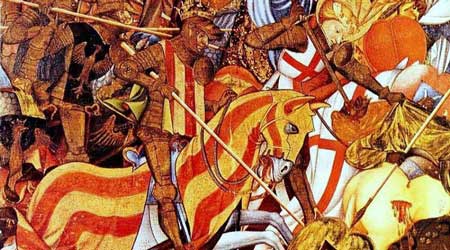Description
Through the investigation of primary and secondary sources, students in this lesson will identify, understand and be able to explain the details of the Reconquista, how Muslim forces came to rule over Christian Iberia, the cultural contributions Spanish Moors developed, and ultimately what led to their downfall after such a long rule.
Subjects
World History
European History
US History
Grade Level
11-12Duration
90 minutesTour Links
- Plaza de Colon, Madrid
- Cathedral of Seville
- Royal Cathedral of Granada
- Alcazar of Toledo
Essential Questions
- Where was Al-Andalus? Who were the Moors? How were they able to conquer Christian Iberia in the 7th century CE?
- What was the Reconquista? How were Christian knights and monarchs able to re-take the Iberian Peninsula from their Moorish neighbors?
- What role did Ferdinand and Isabella play in the Reconquest?
- Is there anything left of Moorish culture in modern Spain?
Key Terms
- Al-Andalus
- Cordoba
- Ferdinand II and Isabella I
- Granada
- Iberian Peninsula
- Islam
- Madrid
- Medieval
- Moorish Culture
- Mosque
- Reconquista
… and there was no one who did not weep abundantly with pleasure giving thanks to Our Lord for what they saw, for they could not keep back the tears; and the Moorish sultan and the Moors who were with him for their part could not disguise the sadness and pain they felt for the joy of the Christians, and certainly with much reason on account of their loss, for Granada is the most distinguished and chief thing in the world …
Contemporary Christian account (unnamed) of the surrender of Granada to Spanish forces, 02 Jan 1492
On 02 Jan 1492, Muhammad XII, Sultan of Granada and last ruler of the Nasrid dynasty, surrendered the Emirate of Granada to King Ferdinand II of Aragon and Queen Isabella I of Castile, united Catholic Monarchs of Spain. The Reconquista was over. For over 700 years, Christian soldiers and kingdoms had been fighting Muslims for control of the Iberian Peninsula. Seven centuries of fighting were over. Seven centuries of division were over. Seven centuries of Moorish control were over.
Catholic Spain would go on to explore and dominate the New World. Spanish institution, religious practices and language dialects would be brought to the corners of the globe. Over the next few centuries, through the use of the Catholic Inquisition and Auto-da-fe practices, Muslims in Spain were forced to leave the peninsula, forced to convert to Catholicism or executed by the state as criminals. Over time, much of Moorish Spain (known as Al-Andalus) was forgotten by a Christian population determined to show the Reconquista as God’s will. Historians today contrast the Iberian Reconquista with the Crusades of the Holy Land.
Through the investigation of primary and secondary sources, students in this lesson will identify, understand and be able to explain the details of the Reconquista, how Muslim forces came to rule over Christian Iberia, the cultural contributions Spanish Moors developed, and ultimately what led to their downfall after such a long rule.

- Students will identify, understand and be able to explain the details of the Reconquista in Iberia from the early days of the Moorish conquest to the collapse of the last Muslim stronghold in 1492.
- Students will identify, understand and be able to explain the contributions to art, architecture, language and culture that the Moors made to Spanish culture.
- Students will identify, understand and be able to explain what happened to the Moors in Spain, how Christian forces were able to complete the Reconquista, and whether a legacy of the fight still exists in modern Spain.
To view resource web pages, download the lesson plan PDF above.
I. Anticipatory Set
- Writing / Question: What does the word “crusade” mean today? (5 min)
- Handouts – Copies of documents and readings from the websites listed. (5 min)
II. Body of Lesson
- Lecture / PPT – The Spanish Reconquest (20 min)
- Video – Moorish Spain (15 min)
- Independent Activity – Students read the articles and sources on the Reconquista, taking notes as appropriate. (20 min)
- Suggestion: Have the students read some of these articles and sources for homework before class.
- Group Activity – Socratic Seminar: Discussion on the Reconquista, why it succeeded and whether there is any legacy of the conflict today in Spain. (15 min)
III. Closure
- Assessment / DBQ – Essay: Explain in detail how Spanish Christians were able to retake the Iberian Peninsula.
Extension
On tour: Plaza de Colón, Madrid
While on tour, students visit the Plaza de Colón in Madrid, where they will find a monument to Columbus. As this lesson shows, the famous explorer had to wait until the completion of the Reconquista in 1492 to make his first voyage. The explorer and his descendants fought the Spanish Crown for many years over what the explorer believed were his rights under various crown proclamations. Ferdinand II and Isabella I, the Catholic Monarchs who completed the Reconquista, are buried in Granada.

